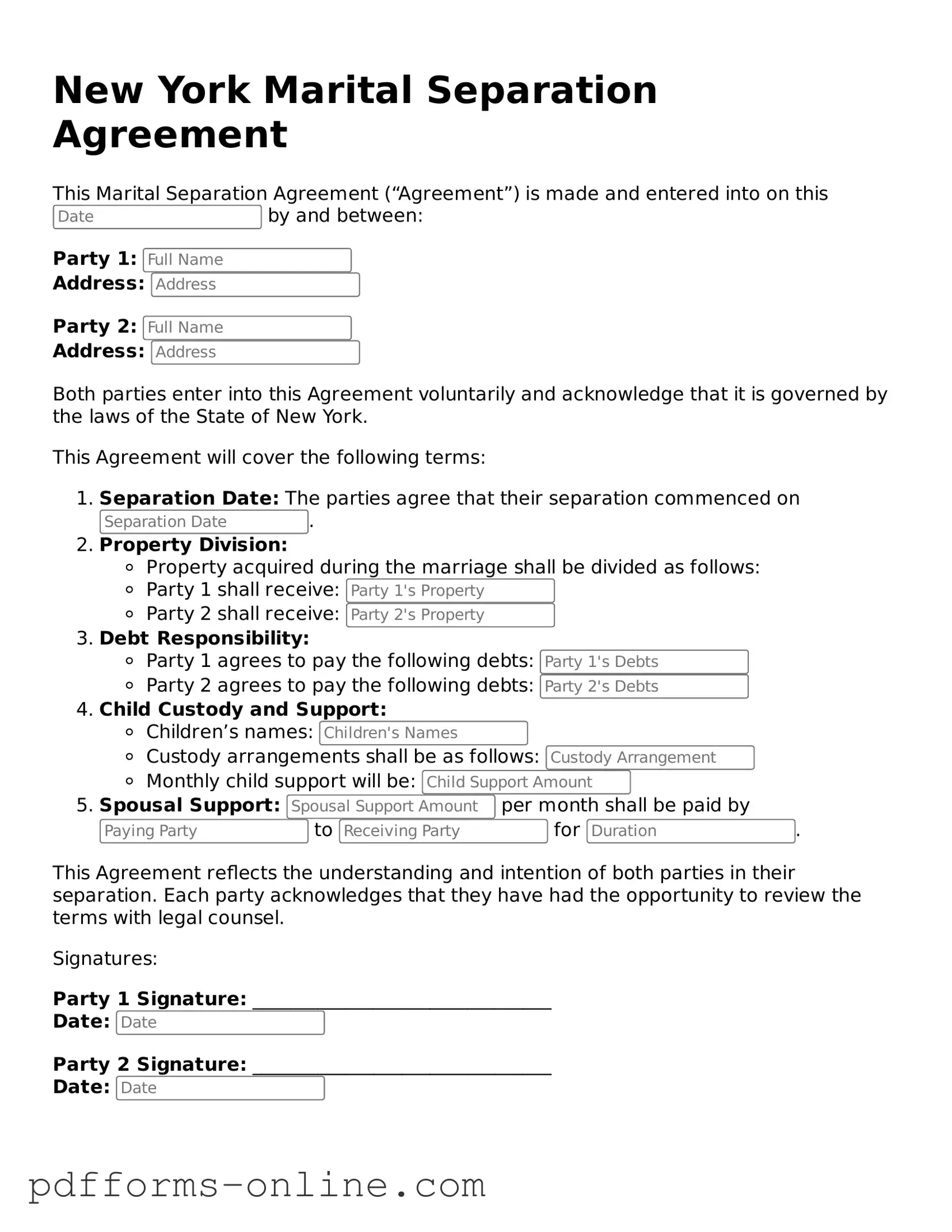The New York Marital Separation Agreement is similar to a Divorce Settlement Agreement. Both documents outline the terms and conditions under which a couple will separate or divorce. They typically address issues such as property division, child custody, and spousal support. While a marital separation agreement can be used when a couple intends to live apart without formally divorcing, a divorce settlement is finalized upon the dissolution of the marriage. Both agreements aim to provide clarity and structure to the separation process.
Another related document is the Child Custody Agreement. This agreement focuses specifically on the arrangements made for the care and custody of children following a separation or divorce. Like the marital separation agreement, it outlines responsibilities and rights regarding parenting time, decision-making authority, and child support. The primary difference is that the child custody agreement is solely concerned with the welfare of the children, while the marital separation agreement encompasses broader financial and property issues.
The Property Settlement Agreement is also similar. This document details how marital assets and debts will be divided between spouses. It is often included as part of a divorce settlement but can be used in conjunction with a marital separation agreement. Both documents require a thorough inventory of assets, and they aim to ensure that both parties understand their rights and obligations regarding property division.
A Cohabitation Agreement shares similarities with a marital separation agreement, particularly when it comes to outlining the rights and responsibilities of partners who live together but are not married. Both documents can address property division and financial support in the event of a separation. However, a cohabitation agreement is typically used by unmarried couples, while a marital separation agreement is specific to married individuals.
The Prenuptial Agreement, or prenup, is another document that bears resemblance to a marital separation agreement. Both agreements are designed to clarify financial arrangements and property rights. A prenuptial agreement is established before marriage, while a marital separation agreement is created during or after the marriage. Both serve to protect individual interests and provide a clear framework for future financial matters.
The Separation Agreement is closely related as well. This document serves as a formal record of the terms under which a couple agrees to live apart. It can address issues like child custody, support, and property division, similar to the marital separation agreement. The key difference lies in the context; a separation agreement may be used in various jurisdictions, while the New York marital separation agreement is specific to New York law.
The Parenting Plan is another important document that parallels the marital separation agreement. This plan specifically outlines how parents will manage their responsibilities regarding their children after separation. It addresses parenting schedules, communication methods, and decision-making processes. While the marital separation agreement can include parenting provisions, the parenting plan focuses exclusively on the children's needs and the parents' roles.
A Mediation Agreement is also relevant in this context. This document is created as a result of mediation sessions between separating spouses. It outlines the agreements reached during mediation regarding various issues such as child custody and division of assets. Like the marital separation agreement, it aims to provide a clear understanding of the terms agreed upon, but it specifically reflects the collaborative nature of mediation.
A Texas Last Will and Testament form is a vital legal document that helps individuals articulate their wishes regarding property and asset distribution after death, thereby preventing ambiguity. This form serves as an essential guide for family members and executors, ensuring that the individual’s desires are explicitly documented and respected. For those seeking more information, resources such as OnlineLawDocs.com provide valuable insights into the intricacies of creating a will.
The Settlement Agreement in a divorce case is akin to a marital separation agreement as well. It encompasses the final terms agreed upon by both parties regarding the dissolution of their marriage. This document typically includes details about asset division, alimony, and child custody arrangements. The key distinction is that a settlement agreement is finalized at the end of the divorce process, while a marital separation agreement may be created during the separation period.
Lastly, the Affidavit of Support can be compared to a marital separation agreement, particularly in cases involving immigration matters. This document is often required when one spouse is sponsoring the other for immigration purposes. It outlines the financial support that the sponsor agrees to provide. While not directly related to separation, it can impact the financial considerations addressed in a marital separation agreement, especially if the couple is separating while navigating immigration issues.
